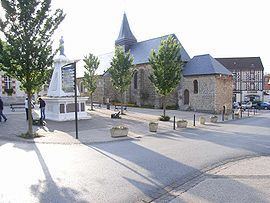Canton Desvres Time zone CET (UTC+1) Area 12.79 km² Population (2014)2 998 | Intercommunality TDC INSEE/Postal code 62899 /62179 Local time Tuesday 9:08 PM Area1 12.79 km2 (4.94 sq mi) | |
 | ||
Weather 10°C, Wind N at 10 km/h, 94% Humidity | ||
Wissant (from Dutch "wit zand"; equal to English "white sand") is a seaside commune in the Pas-de-Calais department in the Hauts-de-France region of France.
Contents
Map of 62179 Wissant, France
Geography
Wissant is a fishing port and farming village located approximately 18 kilometres (11 mi) north of Boulogne, 16 kilometres (9.9 mi) west-southwest of Calais, 36 kilometres (22 mi) southeast of Dover, 53 kilometres (33 mi) west-southwest of Dunkirk, 66 kilometres (41 mi) from the Belgian coast, 191 kilometres (119 mi) north of Le Havre, 523 kilometres (325 mi) northeast of Brest, and 231 kilometres (144 mi) north of Paris, at the junction of the D238 and the D940 roads, on the English Channel coast.
History
Located at the eastern end of a lagoon formed by a storm-breach of the coastal dunes, probably in the mid-10th century, Wissant has been a fishing village for a millennium: along with Audresselles it is the last fishing village in France to use a traditional method of fishing using a wooden boat called a flobart and was in the Middle Ages a major port for embarkation for England: In a mid-11th century Life of St. Vulganius, Wissant was specified, probably anachronistically, as the natural disembarkation point for the early eighth-century Celtic saint in his evangelizing travels. Wissant was the embarkation port of Robert de Beaumont, 4th Earl of Leicester, for his ill-fated invasion of England in 1173, with an army of 3000 Flemings. Henry III of England of England was stranded at Wissant for lack of cash. According to Matthew Paris (mid-13th century) its naucleri habitually interfered with English fishing fleets.
From the 7th to the 14th century, the local language was the West Franconian dialect called Old Dutch and the village was called Witsant and reckoned part of Flanders.
Shifting coastal sands silted up the harbor, at the same time that Calais was rising in importance as a port towards the end of the 12th century. Grierson 1941:81. At the end of the 19th century, the coastal dunes of Wissant began to be covered with seaside villas. During the 20th century, an entrepreneur, Mr. Létendart from Calais, extracted sand and gravel from the dunes to the west of Wissant, in the bed of the ancient lagoon. The huge excavations now form lakes and a nature reserve. At the time of the exploitation of these gravel pits, the bones of a complete mammoth with its tusks were discovered by four workers.
In July 1909 Wissant stood at the centre of worldwide focus. Three contenders for the £1,000 Northcliffe prize offered by the Daily Mail for the first heavier-than-air craft to cross the English channel were camped along the coast between Calais and Wissant. The Franco-Russian Comte Charles de Lambert who had two Wright Flyers (Nos. 2 and 18) and was camped at Wissant.. While practising over the dunes he crashed heavily and cancelled his plans. Louis Blériot won the prize and worldwide fame, from his camp at Calais.
Today, because of the frequent and usually favourable winds and the proximity of the TGV railway station and the Eurostar trains to Frethun, Parisians call Wissant the "Mecca” of surfing.
Notable people
Jacques and Pierre de Wissant were, with four other, voluntarily hostages in the siege of Calais during the 100-years war, and on 4 August 1347 they went barefooted and dressed only with shirts and ropes around their necks to the English king who had intended to leave them to die as a retaliation for his losses in that siege. Only by Queen Philippa of Hainaut's request the six men were saved. Auguste Rodin used this subject for his famous sculpture The Burghers of Calais (1889).
The French President Charles de Gaulle had a small summer house in Wissant that still exists today.
Population
The inhabitants are called Wissantais.
